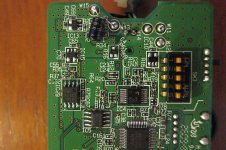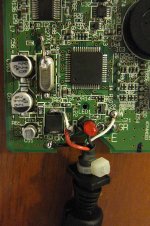This one does it all.... and has nice software as well.... Here's my quick review (I posted elsewhere) in case anyone is considering buying this interface:
I bought UA-1G to transfer audio tapes to HDD in 16/44 format. I modify high end Hi-Fi equipment and quality maters to me. I was sceptical about the sound quality when I ordered it, but gave it a shot. There's also optical in/out to transfer mini discs as well. So, there's no doubt it is a great value for money. The software looks okay and is easy to use. I am not musician by any means and all I need the software to do for me is to record from one audio track. Sometimes I use input pan, and that’s it. Exporting is from 24/44.1 to 16/44.1. This gives good results and is quick – no re-sampling required. Note here: I extensively tested all options and various export file resolutions. 24/96 works really good with a lot of ambiance and detail. It also sounds least fatiguing! However, the low frequency definition suffers compared to 16/44.1, so at the end I settled for 16/44.1 export format and 24/44.1 capture (with advanced driver in ON position). Selecting the ASIO driver wasn’t the problem neither… I used the reset utility posted above (thanks Simon!)
Now – the sound quality….
In its original form, the sound is a bit soft for my liking. I remember having 002 audio interface (with ProTools 7.3.1) at my place for couple of weeks. This was also a bit soft for my taste… but that was before I modified it. After the mods were done, this audio interface sounded amazing… but it required major rework. The UA-1G sounded similar – soft and slightly shut-in. But still it sounded really good for the money! So, can it be improved? Definitely, but I did not want to go with external power supply. The whole package is very portable and handy, so installing an additional jack for 5V DC in and using low noise external power supply would be really cumbersome. So, the only other solution was to check what could be done with PC USB power (ouch!). Before I start, here are some details about A-to-D / D-to-A chip and DIR chip:
A-to-D and D-to-A chip is AK4556 (very high quality device designed for portable audio)
DIR is AK4114 (very capable digital audio interface device)
So, the hardware is there… but single +5V rail took its toll. There are too many signal coupling caps, but there’s no other way with +5V DC, unfortunately.
3 things I did to boost the quality:
1. I used an extra filtering cap at the “input” where the USB power is fed to the UA-1G PCB. The capacitor in question is probably the best (still) available – Black Gate 0.1uF /50V N type. I soldered it on the PCB “under-side” right across black and red wires.
2. The in-series inductor used at the “input” (as filter) is bypassed with a peace of ribbon (wire). The idea is great (to filter high frequency noise coming from the PC USB port)… but it just never works with large inductance in series with power supply rails… The above mentioned Black Gate is great at doing this job. I measured DC drop of 200mV across this choke (inductor) with UA-1G fully “loaded” – so there’s plenty of small diameter wire windings that should definitely be bypassed.
3. The crystal oscillator (6MHz) case was grounded. I used a bit of ribbon (wire) and soldered the case to ground.
The result?
Sound firmed-up and gained in definition – just what I wanted. The original tape and the exported file sounded almost identical. There was just a very tiny hint of softness still present in exported file, but I blame cheap and long-ish USB litz cable for this. The end-result was excellent.
Boky
I bought UA-1G to transfer audio tapes to HDD in 16/44 format. I modify high end Hi-Fi equipment and quality maters to me. I was sceptical about the sound quality when I ordered it, but gave it a shot. There's also optical in/out to transfer mini discs as well. So, there's no doubt it is a great value for money. The software looks okay and is easy to use. I am not musician by any means and all I need the software to do for me is to record from one audio track. Sometimes I use input pan, and that’s it. Exporting is from 24/44.1 to 16/44.1. This gives good results and is quick – no re-sampling required. Note here: I extensively tested all options and various export file resolutions. 24/96 works really good with a lot of ambiance and detail. It also sounds least fatiguing! However, the low frequency definition suffers compared to 16/44.1, so at the end I settled for 16/44.1 export format and 24/44.1 capture (with advanced driver in ON position). Selecting the ASIO driver wasn’t the problem neither… I used the reset utility posted above (thanks Simon!)
Now – the sound quality….
In its original form, the sound is a bit soft for my liking. I remember having 002 audio interface (with ProTools 7.3.1) at my place for couple of weeks. This was also a bit soft for my taste… but that was before I modified it. After the mods were done, this audio interface sounded amazing… but it required major rework. The UA-1G sounded similar – soft and slightly shut-in. But still it sounded really good for the money! So, can it be improved? Definitely, but I did not want to go with external power supply. The whole package is very portable and handy, so installing an additional jack for 5V DC in and using low noise external power supply would be really cumbersome. So, the only other solution was to check what could be done with PC USB power (ouch!). Before I start, here are some details about A-to-D / D-to-A chip and DIR chip:
A-to-D and D-to-A chip is AK4556 (very high quality device designed for portable audio)
DIR is AK4114 (very capable digital audio interface device)
So, the hardware is there… but single +5V rail took its toll. There are too many signal coupling caps, but there’s no other way with +5V DC, unfortunately.
3 things I did to boost the quality:
1. I used an extra filtering cap at the “input” where the USB power is fed to the UA-1G PCB. The capacitor in question is probably the best (still) available – Black Gate 0.1uF /50V N type. I soldered it on the PCB “under-side” right across black and red wires.
2. The in-series inductor used at the “input” (as filter) is bypassed with a peace of ribbon (wire). The idea is great (to filter high frequency noise coming from the PC USB port)… but it just never works with large inductance in series with power supply rails… The above mentioned Black Gate is great at doing this job. I measured DC drop of 200mV across this choke (inductor) with UA-1G fully “loaded” – so there’s plenty of small diameter wire windings that should definitely be bypassed.
3. The crystal oscillator (6MHz) case was grounded. I used a bit of ribbon (wire) and soldered the case to ground.
The result?
Sound firmed-up and gained in definition – just what I wanted. The original tape and the exported file sounded almost identical. There was just a very tiny hint of softness still present in exported file, but I blame cheap and long-ish USB litz cable for this. The end-result was excellent.
Boky
Hi,
do you have any pictures from your modifications?
It would be interesting to use Rightmarks Audio Analyzer to make some Benchmarks-Test and next week (when my unmodded UA-1G arrives) I can make the same Bench for comparison. Maybe we can measure your improvements? Just a idea.
Thanks
Alan
do you have any pictures from your modifications?
It would be interesting to use Rightmarks Audio Analyzer to make some Benchmarks-Test and next week (when my unmodded UA-1G arrives) I can make the same Bench for comparison. Maybe we can measure your improvements? Just a idea.
Thanks
Alan
I do not know what software you use but getting 16bit directly from 24bit is definitely a bad idea - without resampling (and dithering) you just truncate the dynamic resolution. A lot of low level distortion...
I do not know what software you use but getting 16bit directly from 24bit is definitely a bad idea - without resampling (and dithering) you just truncate the dynamic resolution. A lot of low level distortion...
The audio interface comes with professional software application called SONAR 6 LE. It allows for many option for audio capture (up to 24bits / 96kHz), it applies filters at 32bits and allows export at all standard combinations from 16/41 to 24/96. It even allows for 192kHz sampling.
Going from 24/96 to 16/41 also allows for two dither profiles - so for around $100 US for hardware AND professional software.... it must be a steal of a century.
I tried it as stand alone DAC (optical in; analog out) and it performed very good.
Once again, the worst part is USB power supply and litz USB cable… the rest is very reasonable (for the money!)
And it complies to that thingy: SCMS so it is not possible to transfer MD’s (that were recorded from original CD) digitally (optically) thru the interface to USB and HDD. This pretty much makes UA-1G optical-in useless!!! I did not know this before I bought it.
I also changed the capture format to 16/44.1 and I'm still "exporting" to 16/44.1 wav - very quick - it is basically the original captured wav file that is "exported". No filters applied (although I like Normalize!) with occasional pan correction.
Boky
Last edited:
Hi,
do you have any pictures from your modifications?
It would be interesting to use Rightmarks Audio Analyzer to make some Benchmarks-Test and next week (when my unmodded UA-1G arrives) I can make the same Bench for comparison. Maybe we can measure your improvements? Just a idea.
Thanks
Alan
I'll take the photo or 2 this weekend and post.
Boky
I definitely do agree with your reservations about the weak power supply and the cable dependence in those devices. I once did a recording with the Edirol UA25 and had to change from a normal 1.5m cable to a 5m one to get more distance to the player - with the result of a lot of strange offsets and other spuriae even when no signal was coming in.
(USB1.1 usually works for that on default).
(USB1.1 usually works for that on default).
Quick question, I want to open up my UA-1G to add COAX SPDIF, because it currently only supports optical SPDIF.
How did you open it up?
How did you open it up?
- Status
- Not open for further replies.
- Home
- Source & Line
- Digital Source
- Cakewalk (by Roland) UA-1G audio interface

